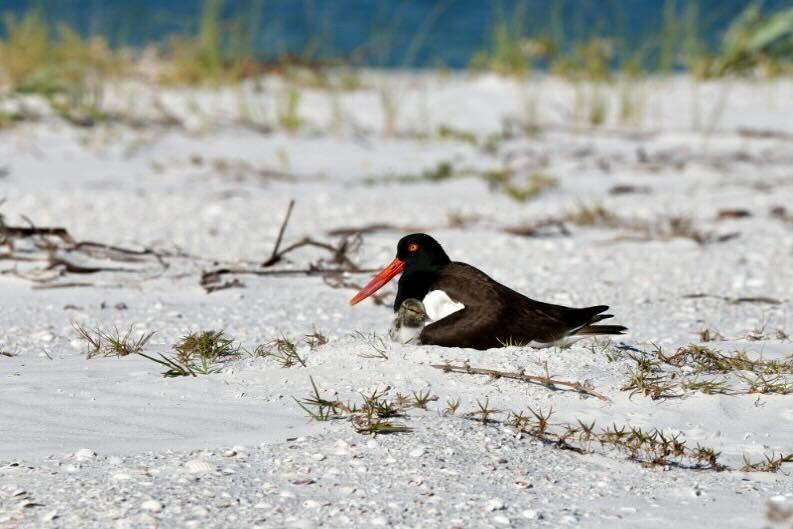
La página que intenta visitar sólo está disponible en inglés. ¡Disculpa!
The page you are about to visit is currently only available in English. Sorry!

By South Pinellas Anchor Steward Sydney Brazzle.
In recent memory, few natural events have reshaped the Tampa Bay coastline as dramatically as the 2024 hurricane season. Hurricanes Helene and Milton left a lasting impression on Florida’s Gulf Coast from which many areas are still recovering. Among the most deeply affected locations was Fort De Soto Park, a treasured natural park known for its diverse bird populations and critical nesting habitats.
Following the hurricanes, Fort De Soto was closed for four months due to extensive damage. While the destruction was undeniable, the reshaped landscape carved by the storms and the limited human presence sparked a rebirth of the park's wildlife.

While the storms ravaged many habitats, they also created entirely new ones. When cleanup and restoration efforts began, certain sections of the park were intentionally set aside from large-scale restoration projects. Instead of using heavy machinery to remove debris, park rangers handpicked through select areas, preserving the fragile ecosystems that were beginning to take shape.
This decision had remarkable outcomes. In one of these protected zones, a pair of American Oystercatchers, known to local conservationists as AE and Archie, successfully nested and fledged two chicks. Another area, the North Beach Bird Sanctuary, provided undisturbed habitat for Least Terns, American Oystercatchers, Willets, and Wilson’s Plovers to nest and raise their young. These areas, although altered by natural disasters, were allowed to flourish organically and still offer adequate conditions for bird nesting.

Outback Key, once a stronghold for nesting shorebirds, has become less suitable due to repeated natural disasters and habitat change over the years. However, a surprising new habitat has emerged farther south along the beach, thanks to the storms’ tidal action.
In the storms’ aftermath, large numbers of pen shells washed ashore, their broken remains forming crevices and hollows in the sand. This pen shell line has surprisingly created an ideal nesting location for Least Terns. The terns have taken advantage of the new terrain and have had a successful season, with many chicks now making their first appearances on the beach.
Not all species have fared as well. Snowy Plovers, typically seen nesting at Fort De Soto, have not returned this season. One theory suggests their absence may be linked to a decline in tiger beetle populations, a key food source that appears to have diminished since the storms. Similarly, the once-bustling lagoon area is now unusually quiet, with fewer birds foraging in its waters. This suggests that the aquatic food web may still be in recovery.

Interestingly, the lack of human activity has played a critical role in some species’ success this season. A section of road within the park, still closed due to post-storm construction, created an unexpected haven for a Wilson’s Plover nest. With no vehicle traffic disturbing the area, the nest has thus far been successful.
All documented nesting this season has occurred in areas with limited human intrusion, from designated bird sanctuaries to temporarily closed roads. This pattern highlights the significant impact of human activity on wildlife and the importance of creating and maintaining spaces where nature can flourish unbothered.
While hurricanes often bring destruction to coastal ecosystems, it also allows for new habitat to form. Fort De Soto is a prime example of this. Critical habitats were lost, but at the same time, nature began to rewrite the landscape. Birds found new ways to thrive in the aftermath of chaos. From opportunistic nesting in pen shells to unexpected sanctuaries formed by closed roads, Fort De Soto stands as a living testament to nature’s resilience and adaptability.
As the park continues its slow recovery, the lessons learned here reinforce the importance of thoughtful restoration. By recognizing the value of minimal intervention in certain areas, we can give wildlife the opportunity to adapt, survive, and indeed flourish — even after a storm. The scale of the challenge facing birds and the planet is daunting. Driving the transformative change needed to “bend the bird curve” will require widespread public support and decisive action. Thank you to those protecting birds and the places they need on our beaches!

Development, climate change impacting habitat birds need for survival.

Seasonal Seabird Steward Ava Trail shares her observations of the nesting species she protects in the Panhandle.

By the numbers.